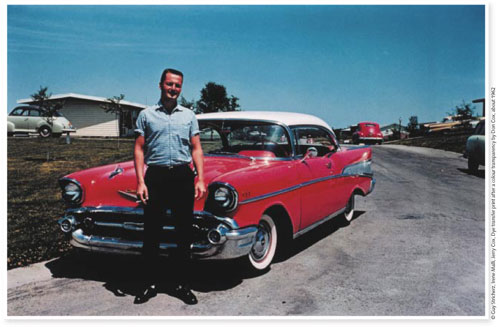
Close to Home: An American Album -
Weston Naef Discusses the Getty Snapshot Exhibition
Interview by Robert Hirsch
From Digital Camera Magazine, 2005

The snapshot’s ability to commemorate people is at the heart of why people make billions of photographs every year. Digital photography has increased the number of snapshots being viewed on computer screens, but it has also resulted in less pictures being printed and saved for the future. Lately a number of United States art institutions, including the J Paul Getty Museum in Los Angeles, have been re-examining the snapshot. I spoke with Weston Naef, the Getty Curator of Photographs, about its exhibition Close to Home: An American Album.
RH: What makes snapshots unique?
WN: When people are making snapshots of social situations they operate almost entirely on instinct, where intuition and spontaneity rule. If elements of planning are incorporated they are designed to bring a smile to the face.
RH: Why do a snapshot exhibition now?
WN: In 2004 we held an exhibition, Photographers of Genius, to address how photography is a medium of expression that is as malleable as the mind and the eye of the person handling the materials. This got me ruminating on the idea there is something we may think of as the genius of photography.
RH: What do you mean by “genius”?
WN: Photography has an element of genius to it, which makes it a little like nature itself. We find examples of nature that possess incredible elements of beauty that attract our eye. They exist as forces of nature where a mysterious combination of predetermination, accident and chance come together. This led me to think of photographs as having an element of nature in them and the medium itself as a force of nature.
RH: How is this show different from other recent snapshot shows?
WN: Other shows have the common thread of the anonymity of the maker. The element that drove the selection process of Close to Home was to redo Edward Steichen’s The Family of Man (1955) from the very perspective of the people represented. Other snapshot shows cover every subject under the sun; Close to Home is about pictures with people in them.
RH: How did you obtain the snapshots?
WN: The first part of the catalogue contains black and white photographs while the second part is devoted to colour. Almost all the B&W pictures were abandoned and recovered, while the colour works were obtained from people who preserved them.
RH: How did you make your curatorial decisions?
WN: We choose pictures for their maximum variety of pose, gesture, expression, costume, and attitude. Each presents a different perspective of everyday man and is emblematic of life’s small pleasures, which only a snapshot can record in such graceful presence.
RH: Why do people collect other people’s photos?
WN: I know creative people who come from broken families, where family photographs disappeared, who are attempting to rebuild a family. Others are redeemers of the abandoned who save the integrity of those faces found in a thrift store.
For more information visit: www.getty.edu/art/exhibitions/close_to_home
|